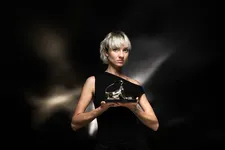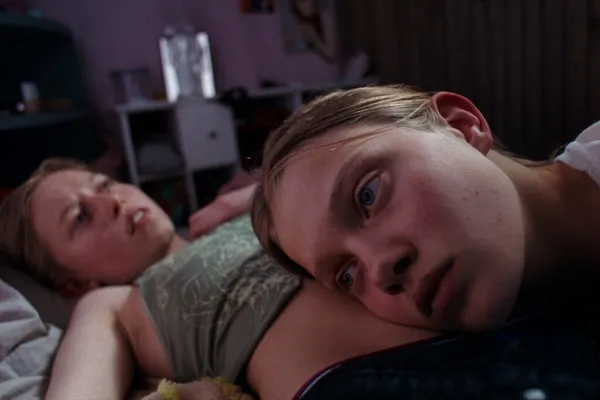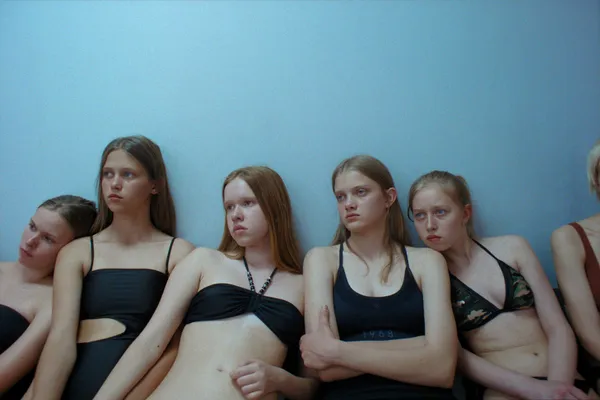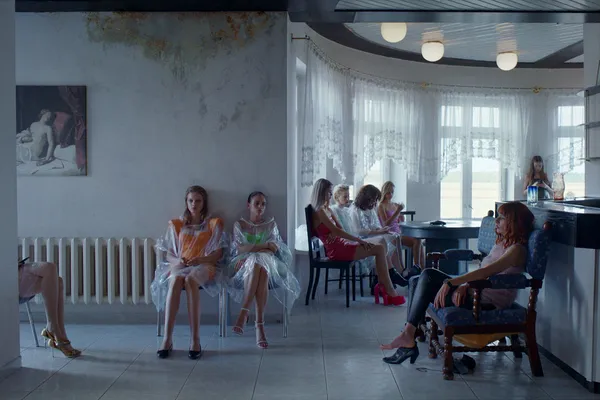Writer/director Saulė Bliuvaitė draws on her own experiences growing up to chart a tale that is as much about the teenagers’ own relationship with their bodies as it is outside influences. Mostly shot in a docureal style, there are experimental flashes that take us into the teenagers’ headspace. We caught up with Bliuvaitė in Sarajevo to talk about the origins of the project, portraying teenagers on film and her mix of technique.
One of the things that’s noticeable about Bliuvaitė’s protagonists is how young they actually appear. Often in film, older actors are often substituted for younger teenagers - the classic example, of course, being Grease - but here the filmmaker is able to emphasise the vulnerability of her characters by casting actors of about the same age, with one of them just 13.
 |
| Saulė Bliuvaitė with her Golden Leopard for Toxic Photo: Locarno Film Festival / Ti-Press |
She recalls: “The producer suggested casting older girls because it's easier for everyone, myself included, that’s what normally happens. But [we chose a younger cast] because this film tackles the topic of adolescent bodies and girls who are not yet experiencing the changes of their body, they're still children and sexuality is projected on them. So I thought that it would be a mistake to have basically adult ladies play girls.
“It would add to the stereotype of what 14-year-olds look like. Normally we see grown-ups playing teenagers and the things that we see them do, like, scenes of intimacy or alcoholic or drug use, and we consider it quite normal for teenagers. I get that when I watch TV series about teenagers played by young adults, and these things seem adequate. But when you see actual 13, 14 or 15-year-olds in these roles, these situations don't seem normal at all. Because we see people who are kids.”
The director also took care not to objectify her young stars.
“From the very beginning I was watching a lot of films about teenagers while preparing for my own film. And I really hate this voyeuristic gaze and I was always thinking why had they chosen this kind of cinematography to portray teenagers because I don’t think it’s right to do certain angles of certain things. It came naturally for me and the cinematographer Vytautas Katkus, because he also naturally approached this film without any voyeurism. It wasn't even a question. We knew what this film is about and there is no need to exotify these bodies again. I think this kind of gaze is so stereotypical and so outdated. I think it comes from older films from the Nineties, especially. I grew up watching those films where if it’s a female body certain angles are used to emphasise sexuality.”
Toxic captures its young protagonists in the halfway house between teenagedom and adulthood, something brought resoundingly home in a key scene where Kristina plays with a doll at the same time as puffing away on a cigarette.
“That was a scene that I really wanted to put in the film,” says Bliuvaitė. “One of the latest cuts in the editing was without the shot and I was really saying to the editor, ‘That’s the right place to put the scene back in because I really want it to be there’. It really sums up, basically, the whole idea that I had behind these characters. They are dealing with these completely different poles. They are just in between, in this kind of limbo and you cannot describe what kind of age is this. They are children but they’re also experiencing adult things.”
 |
| Ieva Rupeikaite and Vesta Matulyte as Marija and Kristina in Toxic. Saulė Bliuvaitė: 'They understood and they could detach themselves from the characters' Photo: Akis Bado |
“It was just so funny because I had to go back to my teenagehood myself,” the filmmaker recalls. “Vesta, the older one, said her father smokes and she tried it and she knows how to do it so it was okay. But the younger one was barely 13 and she’d never done it and she was very scared. I said, ‘We have to go and just try before the shooting so that you know how to hold it’. And I asked the producer, ‘Where should we go? We can't do it in the office’. And she said just go outside in the parking lot.
“I remember the three of us going to the parking lot and we were just so scared. I taught her how to inhale and every time someone passed they looked at us really scared because I looked like a mother to them, teaching a child. I was so scared.
“They [the young stars] were really conscious about all of these things. I think that was part of the reason why I cast them not only because of their acting abilities but also who they are as people. They understood and they could detach themselves from the characters. I could direct this film with them because we didn't have any problem with them going too much into the character. It was just very technical all of the scenes with cigarettes or alcohol and drugs or intimacy. They weren't even so excited about smoking... ‘Oh no. We have to do it today’.
It’s not just in terms of the young cast that Bliuvaitė keeps things real, she also takes a clear-eyed view of the town where the youngsters live. There’s no sense of the director looking down at her characters, however, or adopting a “poverty porn” approach.
She notes: “People who exoticse things, that happens when you actually don't personally know this kind of environment, so you watch it like an outsider and exotify it. But I come from humble beginnings and I really feel for people who struggle day by day to sustain an adequate lifestyle and to provide for themselves and their children.”
Although Toxic is structured around friendship and coming-of-age, it also deals with body dysmorphia and eating disorders, with the girls encouraged by the modelling company to be the perfect weight for the camera. Again, Bliuvaitė pulls off a delicate balancing act in order to avoid any glorification of the idea.
She says: “I wasn't planning on explaining step-by-step what is happening with Kristina, who is struggling with body dysmorphia. I put some moments of her struggle in but with little explanation because I also thought this film is not about eating disorders per se. I chose to show - I would call them ugly - scenes. The puking and the tapeworm and the rotten food with maggots. Tapeworm was a Victorian thing, I’m not sure if it still exists but I thought that it's a great symbol to take for Kristina's character, especially, because she just wants to become thin to the point of disappearing. It's a very destructive mindset. I still don't know in the story if she actually took this tapeworm or she just thought that she did. I can't decide, because it could be both ways. It was nice not to know this because you can be justifiable both ways.”
“When developing the script it just came naturally, these surrealistic elements, to just plant them throughout the story,” says Bliuvaitė “Sometimes when I was writing a scene, I thought this could express what she's feeling now. Actually, we did have more details or scenes of that sort but in the editing room we cut a lot of it, so there was just 30 per cent left. We had some weird stuff going on with Marija, the main character, levitating, some magic in her grandma's house. But in the editing room with Ignė Narbutaitė, the editor, we realised minimal magic moments really worked better for the story because these surreal elements would really steal all the thunder from the actual problems being portrayed in the film. I wanted the audience to connect to the girls and what they are going through but just to make their experiences feel stronger.”
Speaking about her own time as a teenager, Bliuvaitė says her experiences were also “like a mystical environment. She adds: “It was not only about my body changing but also about dreams and thinking that there is something outside of reality. I think I was 16 when I started to think about what's outside the reality that I'm living in. What’s outside this apartment or my family - something else is there and I wanted to express that in the film. Some kind of spirituality.”
The director spent several months preparing for the film and workshopping with her two stars in order to develop the naturalism that we see onscreen.
“In the actual film, we don't see a lot of things. Something is out of the frame and left as a secret and we don't know what happened but with the girls we needed to go through these stereotypical friend situations that are not in the film. I realised that and I would give them very stereotypical very boring scenesI would say even you know, like from a teen flick. But they needed to go through it to build their bond and to better understand what was happening in the story.
“The professional actors also joined. They weren't so keen on preparing for the scenes that we were not going to shoot. They were sceptical at first, but they loved it. I think that the thing for both actresses at first was just to get the vibe. How much should I move? How expressive should I be? I love this very minimalistic acting, like documentary style and the girls at first thought that, ‘Okay, we're acting. So we're like moving on stage and doing this very broad performance and speaking very loud’. But after some time they got the vibe. I think we reached the point where during the scene they were talking the same way as after I said, ‘Cut’.”
The Golden Leopard win in Locarno was “absolutely unexpected” and an “insane experience” says Bliuvaitė. She adds: “Everyone is asking me, what's next? But I would say I'm cherishing this moment with this film. Now there are these enormous expectations because it's just the start. I don't know when I'm going to make the next song, maybe in 10 years. Well, I hope not. Maybe I'll just rest and will have some ideas.”


























